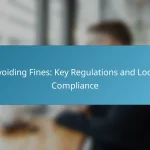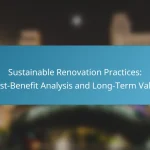What are the essential post-renovation maintenance tips?
Essential post-renovation maintenance tips focus on ensuring the longevity and safety of your newly renovated space. Regular attention to structural integrity, cleanliness, and system functionality can prevent costly repairs and enhance comfort.
Regular inspection of structural integrity
Regularly inspecting the structural integrity of your renovation is crucial for identifying potential issues early. Look for cracks in walls, uneven floors, or signs of settling that may indicate underlying problems.
Schedule inspections at least twice a year, and consider hiring a professional if you notice significant changes. Keeping a log of inspections can help track any developments over time.
Routine cleaning of surfaces
Routine cleaning of surfaces helps maintain the aesthetic appeal and hygiene of your renovated space. Dust, dirt, and debris can accumulate quickly, especially in newly renovated areas.
Establish a cleaning schedule that includes dusting, vacuuming, and wiping down surfaces at least once a week. Use appropriate cleaning products for different materials to avoid damage.
Checking for water leaks
Checking for water leaks is essential to prevent water damage and mold growth in your renovated home. Inspect areas around sinks, toilets, and appliances regularly for signs of moisture or leaks.
Consider installing water leak detectors in critical areas, which can alert you to leaks before they cause significant damage. Address any leaks immediately to minimize repair costs.
Maintaining HVAC systems
Maintaining HVAC systems is vital for ensuring comfortable indoor air quality and energy efficiency. Schedule regular maintenance checks at least once a year to clean filters, check ducts, and ensure proper functioning.
Replace air filters every 1-3 months, especially if you have pets or live in a dusty area. Keeping your HVAC system in good condition can reduce energy bills and extend its lifespan.
Updating safety features
Updating safety features after a renovation is crucial for protecting your home and its occupants. Ensure smoke detectors, carbon monoxide detectors, and fire extinguishers are installed and functioning properly.
Check local regulations for safety standards and consider upgrading to smart safety devices that can alert you to issues via your smartphone. Regularly test these devices to ensure they are operational.
How to maintain newly installed flooring?
Maintaining newly installed flooring is essential for preserving its appearance and longevity. Regular care and the right products can prevent damage and keep your floors looking their best.
Use appropriate cleaning products
Choosing the right cleaning products is crucial for maintaining your flooring. For hardwood, use pH-balanced cleaners specifically designed for wood, while laminate requires gentle solutions that won’t leave residue. Avoid harsh chemicals that can strip finishes or damage materials.
Always check the manufacturer’s recommendations for cleaning products to ensure compatibility with your flooring type. Using the wrong product can lead to discoloration or deterioration over time.
Implement regular sweeping and mopping
Regular sweeping and mopping are vital for keeping your floors free from dirt and debris. Aim to sweep at least once a week and mop every month, adjusting frequency based on foot traffic. Use a soft-bristle broom or a vacuum with a hard floor setting to avoid scratches.
When mopping, use a damp mop rather than soaking the floor, as excessive moisture can damage certain flooring types. For best results, follow up with a dry mop to eliminate any remaining moisture.
Monitor humidity levels
Humidity levels can significantly affect the condition of your flooring, especially for wood. Ideally, maintain indoor humidity between 30% and 50% to prevent warping or cracking. Use a dehumidifier in damp conditions or a humidifier during dry seasons to stabilize moisture levels.
Regularly check humidity with a hygrometer, and take action if levels fall outside the ideal range. This proactive approach can help extend the life of your flooring and maintain its aesthetic appeal.
What are the best practices for exterior maintenance?
Best practices for exterior maintenance focus on regular inspections and timely repairs to protect your home from damage. Prioritizing these tasks can extend the life of your property and enhance its curb appeal.
Inspect roofing and gutters
Regularly inspecting your roofing and gutters is crucial for preventing water damage and structural issues. Look for missing shingles, cracks, or signs of wear on the roof, and ensure gutters are free of debris to allow proper drainage.
Consider scheduling inspections at least twice a year, especially after severe weather. If you notice any issues, address them promptly to avoid costly repairs later.
Maintain landscaping and drainage
Proper landscaping and drainage management can prevent water pooling around your foundation, which can lead to serious damage. Ensure that soil slopes away from the house and that plants are not too close to the structure.
Regularly check drainage systems, such as French drains or downspouts, to ensure they function correctly. Prune overgrown plants and remove any debris that could obstruct water flow.
Check for paint and siding wear
Inspecting paint and siding for wear is essential to protect your home from moisture and pests. Look for peeling paint, cracks, or fading, as these can indicate the need for touch-ups or a full repaint.
Repainting every 5-10 years is a good rule of thumb, depending on your local climate. Use high-quality exterior paint and materials to enhance durability and reduce maintenance frequency.
How to care for new appliances after renovation?
Caring for new appliances after a renovation involves following specific maintenance practices to ensure longevity and optimal performance. Regular attention to these appliances can help prevent issues and maintain their efficiency.
Follow manufacturer maintenance guidelines
Each appliance comes with a set of manufacturer maintenance guidelines that outline the best practices for care. These guidelines typically include cleaning instructions, recommended products, and specific maintenance tasks to perform regularly.
For example, a refrigerator may require periodic cleaning of the condenser coils and checking the door seals for proper function. Ignoring these guidelines can lead to reduced efficiency and increased energy costs.
Schedule regular servicing
Regular servicing is essential for maintaining the performance of new appliances. Depending on the type of appliance, consider scheduling professional maintenance at least once a year to address any potential issues before they escalate.
For instance, dishwashers and washing machines benefit from annual inspections to check for leaks and ensure that all components are functioning correctly. Keeping a service log can help track maintenance dates and any repairs performed.
What tools are essential for post-renovation maintenance?
Essential tools for post-renovation maintenance include a variety of hand tools and power tools that help with repairs and upkeep. Having the right equipment on hand ensures that you can address any issues that arise after your renovation is complete.
Basic tool kit
A basic tool kit should include items like a hammer, screwdrivers, pliers, and a tape measure. These tools are fundamental for most maintenance tasks, allowing you to make quick adjustments or repairs around your home.
Consider adding a level and a utility knife to your kit for more precise work. A level helps ensure that shelves and fixtures are straight, while a utility knife is handy for cutting materials during repairs.
For those who may not have a lot of space, opt for a compact tool kit that includes multi-tools or a combination of essential items. This can save space while still providing you with the necessary tools for post-renovation maintenance tasks.






